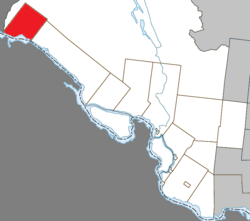Rapides-des-Joachims, Quebec
| Rapides-des-Joachims | |
|---|---|
| Municipality | |
 |
|
| Nickname(s): Swisha, The Swisha | |
 Location within Pontiac RCM. |
|
| Location in western Quebec. | |
| Coordinates: 46°12′N 77°41′W / 46.200°N 77.683°WCoordinates: 46°12′N 77°41′W / 46.200°N 77.683°W | |
| Country |
|
| Province |
|
| Region | Outaouais |
| RCM | Pontiac |
| Settled | 17th century |
| Constituted | January 1, 1955 |
| Government | |
| • Mayor | James Gibson |
| • Federal riding | Pontiac |
| • Prov. riding | Pontiac |
| Area | |
| • Total | 257.10 km2 (99.27 sq mi) |
| • Land | 242.86 km2 (93.77 sq mi) |
| Population (2011) | |
| • Total | 131 |
| • Density | 0.5/km2 (1/sq mi) |
| • Pop 2006-2011 |
|
| • Dwellings | 83 |
| Time zone | EST (UTC−5) |
| • Summer (DST) | EDT (UTC−4) |
| Postal code(s) | J0X 3M0 |
| Area code(s) | 613 |
| Highways | No major routes |
| Website | www desjoachims |
Rapides-des-Joachims is a municipality and village in western Quebec, Canada, part of Pontiac County in the Outaouais region. The village is situated on Rapides-des-Joachims Island (l'île de Rapides-des-Joachims) on the Ottawa River, about 100 km northwest of Fort-Coulonge. It is also known as Swisha.
The municipality covers a vast sparsely populated area characterized by boreal forest, lakes, and streams. Prior to the construction of a hydro-electric dam in 1950, the village's site was not an island. The rising water flooded the old river bed from the north through Lake McConnell. The dam can be bypassed on one of the Ottawa Navigable Waterway bypasses, connecting the Pembroke stretch of the Ottawa River to the upstream section to Mattawa.
Rapides-des-Joachims is isolated from the rest of Quebec's road network because the only paved road link to the village is through Rolphton, Ontario. It is the only community on the Quebec side of the Ottawa River between Sheenboro and Témiscaming. Because it is also isolated from Quebec's telecommunications network, the community is part of Rolphton's telephone exchange area, and is consequently served by Ontario's area code 613 rather than Quebec's area code 819.
The site had long been inhabited by the indigenous people before Europeans arrived. The explorers and voyageurs of the seventeenth and eighteenth centuries would travel on the Ottawa River to the west and at the foot of the rapids, they would have established a resting place and may have given it the name of an explorer.
It was a busy place during the seventeenth century, when a mission post was set up along the river where a Hudson's Bay Company trading post had been established at the foot of the "Long Rapids", as they were called at the time.
...
Wikipedia

